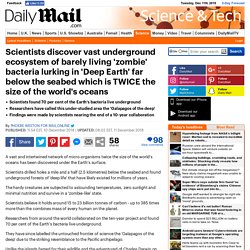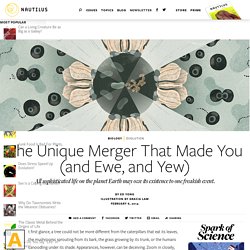

Barely living 'zombie' bacteria in Deep Earth are made up of 15 to 23 billion tons of carbon. A vast and intertwined network of micro-organisms twice the size of the world's oceans has been discovered under the Earth's surface.

Scientists drilled holes a mile and a half (2.5 kilometres) below the seabed and found underground forests of 'deep life' that have likely existed for millions of years. The hardy creatures are subjected to astounding temperatures, zero sunlight and minimal nutrition and survive in a 'zombie-like' state. Scientists believe it holds around 15 to 23 billion tonnes of carbon - up to 385 times more than the combines mass of every human on the planet. Researchers from around the world collaborated on the ten-year project and found 70 per cent of the Earth's bacteria live underground. They have since labelled the untouched frontier of science the 'Galapagos of the deep' due to the striking resemblance to the Pacific archipelago.
Scroll down for video 'Zombie' bacteria and other forms of life constitute an immense amount of carbon deep within Earth's subsurface.
The Unique Merger That Made You (and Ewe, and Yew) - Issue 10: Mergers & Acquisitions. At first glance, a tree could not be more different from the caterpillars that eat its leaves, the mushrooms sprouting from its bark, the grass growing by its trunk, or the humans canoodling under its shade.

Appearances, however, can be deceiving. Zoom in closely, and you will see that these organisms are all surprisingly similar at a microscopic level. Specifically, they all consist of cells that share the same basic architecture. These cells contain a central nucleus—a command center that is stuffed with DNA and walled off by a membrane. Surrounding it are many smaller compartments that act like tiny organs, carrying out specialized tasks like storing molecules or making proteins.
This combination of features is shared by almost every cell in every animal, plant, fungus, and alga, a group of organisms known as “eukaryotes.” Bacteria showcase a second, simpler way of building a cell—one that preceded the complex eukaryotes by at least a billion years. It is not for lack of opportunity. Cosmic Calendar. The Cosmic Calendar is a method to visualize the vast history of the universe in which its 13.8 billion year lifetime is condensed down into a single year.

In this visualization, the Big Bang took place at the beginning of January 1 at midnight, and the current moment is mapped onto the end of December 31 at midnight.[1] At this scale, there are 438 years per second, 1.58 million years per hour, and 37.8 million years per day. This concept was popularized by Carl Sagan in his book The Dragons of Eden and on his television series Cosmos.[2] (In the 2014 sequel series, Cosmos: A Spacetime Odyssey, host Neil deGrasse Tyson presents the same concept of a Cosmic Calendar, but using the revised age of the universe of 13.8 billion years[3] as an improvement on Sagan's 1980 figure of 15 billion years.) The Cosmic Year[edit] The 13.8 billion year history of the universe mapped onto a single year, as popularized by Carl Sagan. Big Bang[edit] Evolution of life on Earth[edit] Human evolution[edit]